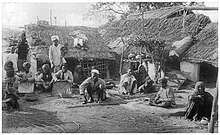Ceast
Is cineál srathaithe shóisialta é ceast[1] (nó sainaicme) arb iad a shainairíonna ná an t-ionghamas, tarchur oidhreachtúil ar stíl mhaireachtála lena n-áirítear go minic slí bheatha, stádas deasghnátha in ordlathas, agus gnáth-idirghníomhaíocht shóisialta agus eisiamh bunaithe ar choincheapa cultúrtha íonachta agus truaillithe.[2][3][4][5][6] Is é an sampla eitneagrafach paraidímeach ná rannán sochaí Hiondúch na hIndia i ngrúpaí sóisialta dochta, le fréamhacha i stair ársa na hIndia agus ag leanúint go dtí an t-am i láthair. Mar sin féin, tá laghdú tagtha ar thábhacht eacnamaíoch chóras na gceastaí san India mar thoradh ar uirbiú agus ar chláir ghníomhaíochta dearfacha. Ina mhórábhar scoláireachta ag socheolaithe agus antraipeolaithe, úsáidtear an córas ceast Hiondúch uaireanta mar bhonn analachúil chun staidéar a dhéanamh ar dheighiltí sóisialta mar a bheadh ceast lasmuigh den Hiondúchas agus an India. Cuirtear an téarma "ceast" i bhfeidhm freisin ar ghrúpálacha moirfeolaíocha i bhfeithidí eoshóisialta amhail seangáin, beacha, agus seangáin bhána.[7]

Tagairtí
cuir in eagar- ↑ Niall Ó Dónaill, eag.: “Foclóir Gaeilge-Béarla (Ó Dónaill): ceast” (ga). Teanglann.ie. An Gúm (1977). Dáta rochtana: 2024-07-05.
- ↑ Lagasse, Paul, ed. (2007), "Caste", The Columbia Encyclopedia, New York, NY: Columbia University Press, ISBN 978-0-231-14446-9, aisghafa 24 September 2012,
caste [Port., casta=basket], ranked groups based on heredity within rigid systems of social stratification, especially those that constitute Hindu India. Some scholars, in fact, deny that true caste systems are found outside India. The caste is a closed group whose members are severely restricted in their choice of occupation and degree of social participation. Marriage outside the caste is prohibited. Social status is determined by the caste of one's birth and may only rarely be transcended.
- ↑ Madan, T. N.; Editors (2012), caste, Encyclopæida Britannica Online,
caste, any of the ranked, hereditary, endogamous social groups, often linked with occupation, that together constitute traditional societies in South Asia, particularly among Hindus in India. Although sometimes used to designate similar groups in other societies, the "caste system" is uniquely developed in Hindu societies.
{{citation}}:|last2=has generic name (cabhair) - ↑ Gupta, Dipankar (2008), "Caste", in Schaefer, Richard T. (ed.), Encyclopedia of Race, Ethnicity, and Society, Thousand Oaks: SAGE, pp. 246–250, ISBN 978-1-4129-2694-2, aisghafa 5 August 2012,
Caste: What makes Indian society unique is the phenomenon of caste. Economic, religious, and linguistic differentiations, even race-based discrimination, are known elsewhere, but nowhere else does one see caste but in India.
- ↑ Mitchell, Geoffrey Duncan (2006), "Castes (part of SOCIAL STRATIFICATION)", A New Dictionary of the Social Sciences, New Brunswick, NJ: Aldine Transaction Publishers, pp. 194–195, ISBN 978-0-202-30878-4, aisghafa 10 August 2012,
Castes A pure caste system is rooted in the religious order and may be thought of as a hierarchy of hereditary, endogamous, occupational groups with positions fixed and mobility barred by ritual distances between each caste. Empirically, the classical Hindu system of India approximated most closely to pure caste. The system existed for some 3,000 years and continues today despite many attempts to get rid of some of its restrictions. It is essentially connected with Hinduism.
- ↑ "caste, n.", Oxford English Dictionary, Second edition; online version June 2012, Oxford, UK: Oxford University Press, 1989, aisghafa 5 August 2019,
caste, n. 2a. spec. One of the several hereditary classes into which society in India has from time immemorial been divided; ... This is now the leading sense, which influences all others.
- ↑ Wilson (1979). "The Evolution of Caste Systems in Social Insects". Proceedings of the American Philosophical Society 123: 204–210. JSTOR 986579.